ACCG101 Accounting and Governance Report: Galore Ltd Case Study
VerifiedAdded on 2022/09/27
|6
|1087
|19
Report
AI Summary
This report analyzes the impact of the allowance for doubtful debts on Galore Ltd's financial statements and growth rate. It explores the factors for estimating the yearly allowance, the impact of different percentages on the company's financial reports, and provides an opinion on the ethical implications of following a suggested approach. The report also discusses the impact of the decision on stakeholders and concludes with the importance of accurate estimation of provision for doubtful debts and adherence to accounting principles and standards, particularly in relation to IFRS. The case study highlights the importance of reflecting a fair and true picture of the company's financial position to stakeholders, supporting the recommendation to follow the suggested approach for a sustainable growth rate.
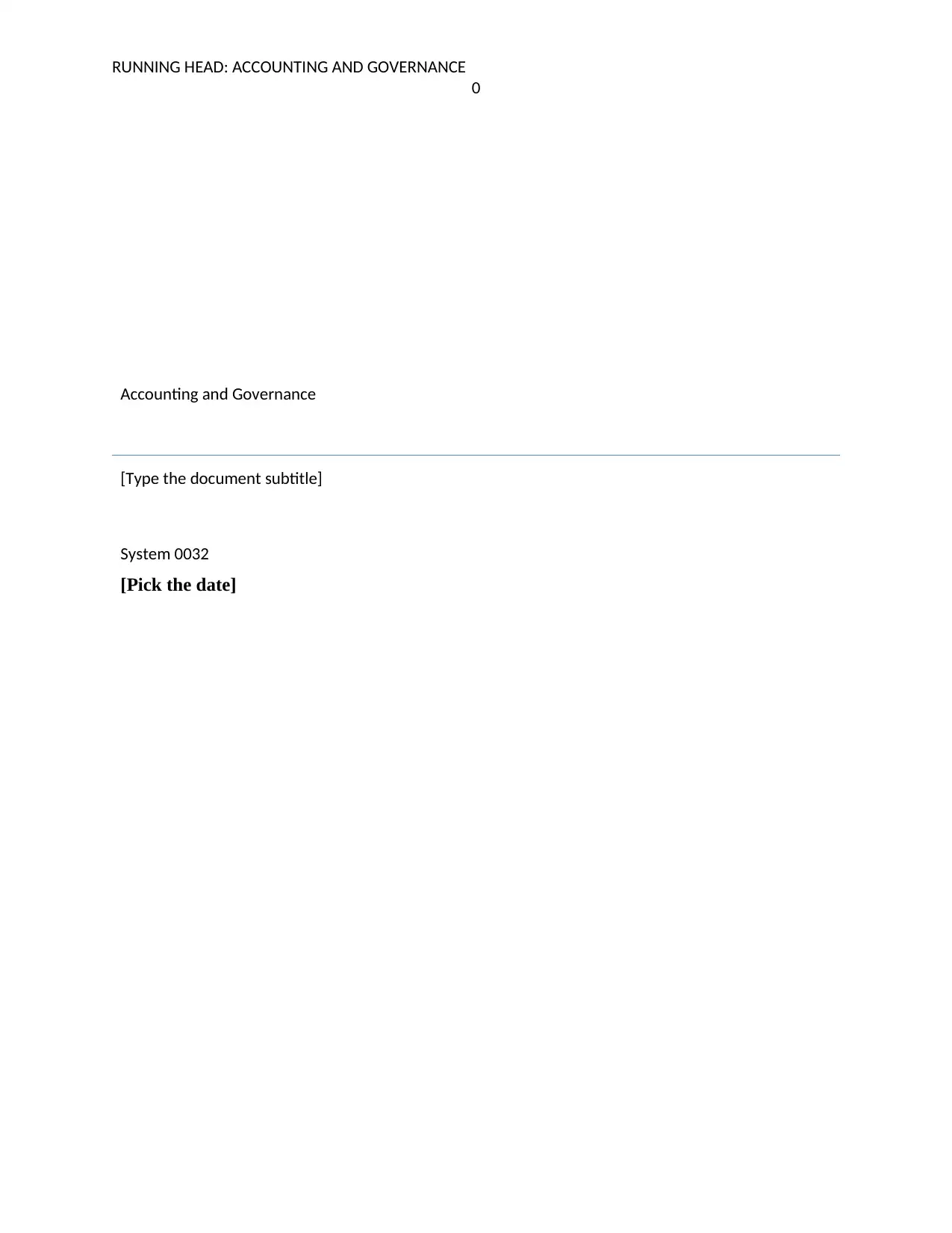
RUNNING HEAD: ACCOUNTING AND GOVERNANCE
0
Accounting and Governance
[Type the document subtitle]
System 0032
[Pick the date]
0
Accounting and Governance
[Type the document subtitle]
System 0032
[Pick the date]
Paraphrase This Document
Need a fresh take? Get an instant paraphrase of this document with our AI Paraphraser
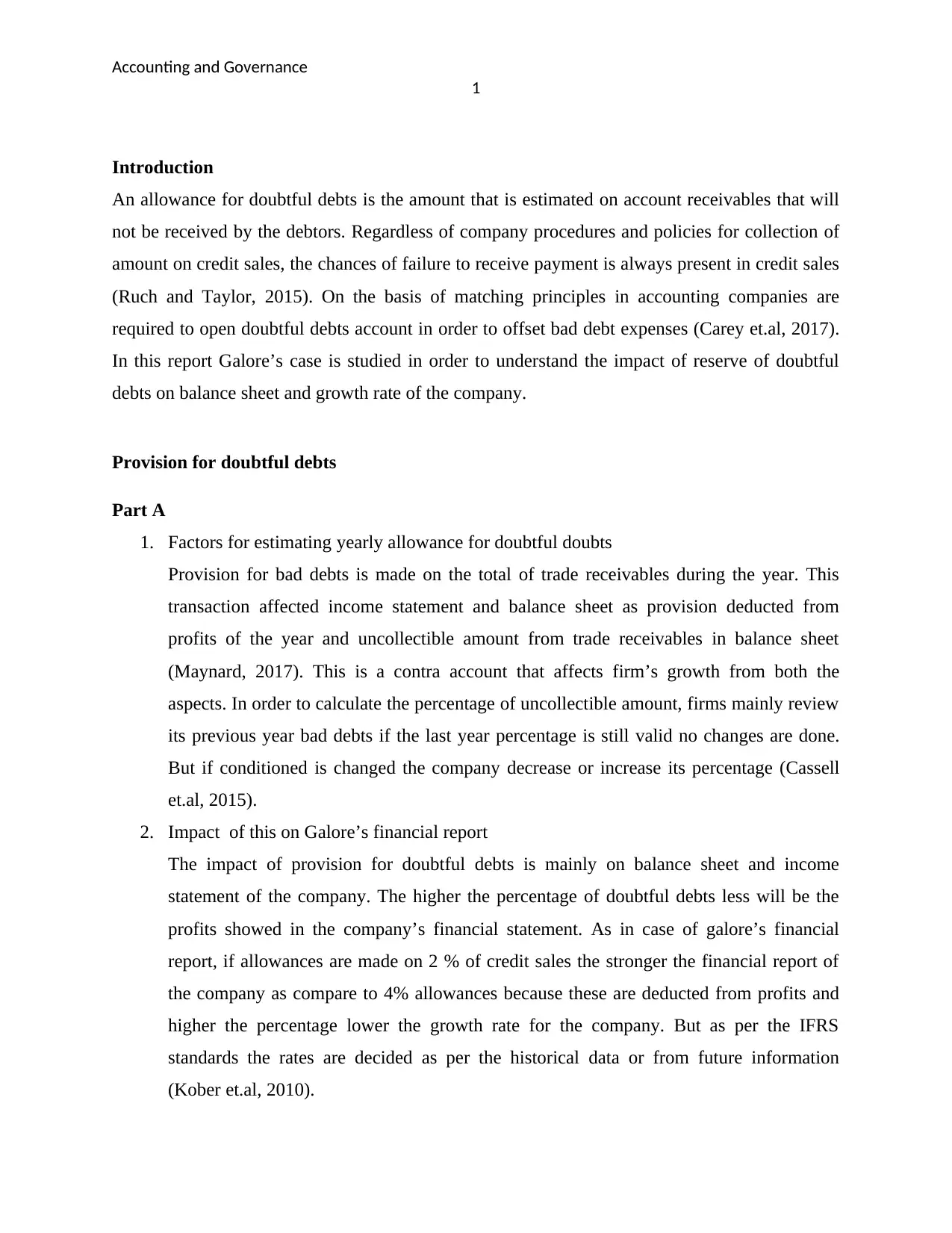
Accounting and Governance
1
Introduction
An allowance for doubtful debts is the amount that is estimated on account receivables that will
not be received by the debtors. Regardless of company procedures and policies for collection of
amount on credit sales, the chances of failure to receive payment is always present in credit sales
(Ruch and Taylor, 2015). On the basis of matching principles in accounting companies are
required to open doubtful debts account in order to offset bad debt expenses (Carey et.al, 2017).
In this report Galore’s case is studied in order to understand the impact of reserve of doubtful
debts on balance sheet and growth rate of the company.
Provision for doubtful debts
Part A
1. Factors for estimating yearly allowance for doubtful doubts
Provision for bad debts is made on the total of trade receivables during the year. This
transaction affected income statement and balance sheet as provision deducted from
profits of the year and uncollectible amount from trade receivables in balance sheet
(Maynard, 2017). This is a contra account that affects firm’s growth from both the
aspects. In order to calculate the percentage of uncollectible amount, firms mainly review
its previous year bad debts if the last year percentage is still valid no changes are done.
But if conditioned is changed the company decrease or increase its percentage (Cassell
et.al, 2015).
2. Impact of this on Galore’s financial report
The impact of provision for doubtful debts is mainly on balance sheet and income
statement of the company. The higher the percentage of doubtful debts less will be the
profits showed in the company’s financial statement. As in case of galore’s financial
report, if allowances are made on 2 % of credit sales the stronger the financial report of
the company as compare to 4% allowances because these are deducted from profits and
higher the percentage lower the growth rate for the company. But as per the IFRS
standards the rates are decided as per the historical data or from future information
(Kober et.al, 2010).
1
Introduction
An allowance for doubtful debts is the amount that is estimated on account receivables that will
not be received by the debtors. Regardless of company procedures and policies for collection of
amount on credit sales, the chances of failure to receive payment is always present in credit sales
(Ruch and Taylor, 2015). On the basis of matching principles in accounting companies are
required to open doubtful debts account in order to offset bad debt expenses (Carey et.al, 2017).
In this report Galore’s case is studied in order to understand the impact of reserve of doubtful
debts on balance sheet and growth rate of the company.
Provision for doubtful debts
Part A
1. Factors for estimating yearly allowance for doubtful doubts
Provision for bad debts is made on the total of trade receivables during the year. This
transaction affected income statement and balance sheet as provision deducted from
profits of the year and uncollectible amount from trade receivables in balance sheet
(Maynard, 2017). This is a contra account that affects firm’s growth from both the
aspects. In order to calculate the percentage of uncollectible amount, firms mainly review
its previous year bad debts if the last year percentage is still valid no changes are done.
But if conditioned is changed the company decrease or increase its percentage (Cassell
et.al, 2015).
2. Impact of this on Galore’s financial report
The impact of provision for doubtful debts is mainly on balance sheet and income
statement of the company. The higher the percentage of doubtful debts less will be the
profits showed in the company’s financial statement. As in case of galore’s financial
report, if allowances are made on 2 % of credit sales the stronger the financial report of
the company as compare to 4% allowances because these are deducted from profits and
higher the percentage lower the growth rate for the company. But as per the IFRS
standards the rates are decided as per the historical data or from future information
(Kober et.al, 2010).

Accounting and Governance
2
2
⊘ This is a preview!⊘
Do you want full access?
Subscribe today to unlock all pages.

Trusted by 1+ million students worldwide
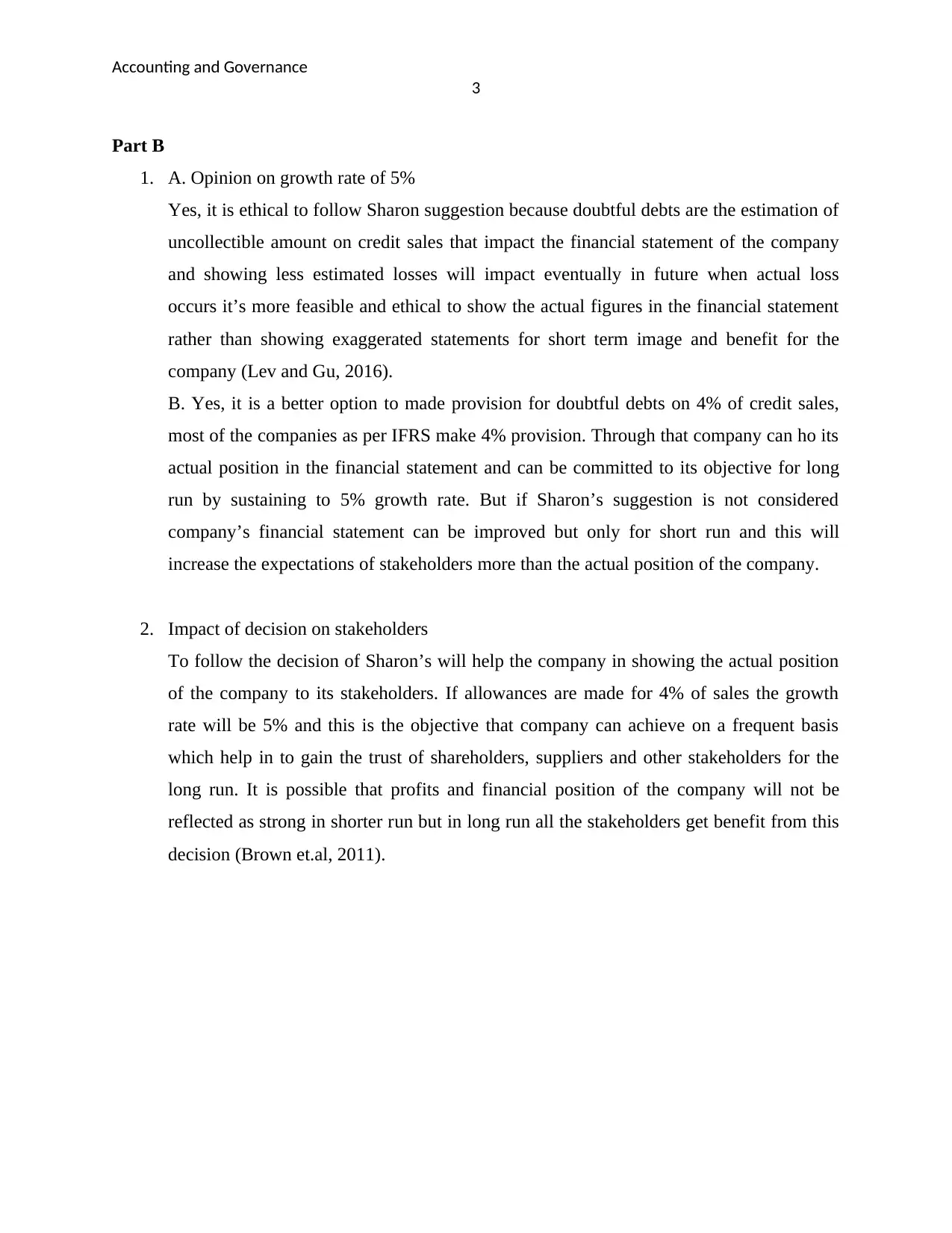
Accounting and Governance
3
Part B
1. A. Opinion on growth rate of 5%
Yes, it is ethical to follow Sharon suggestion because doubtful debts are the estimation of
uncollectible amount on credit sales that impact the financial statement of the company
and showing less estimated losses will impact eventually in future when actual loss
occurs it’s more feasible and ethical to show the actual figures in the financial statement
rather than showing exaggerated statements for short term image and benefit for the
company (Lev and Gu, 2016).
B. Yes, it is a better option to made provision for doubtful debts on 4% of credit sales,
most of the companies as per IFRS make 4% provision. Through that company can ho its
actual position in the financial statement and can be committed to its objective for long
run by sustaining to 5% growth rate. But if Sharon’s suggestion is not considered
company’s financial statement can be improved but only for short run and this will
increase the expectations of stakeholders more than the actual position of the company.
2. Impact of decision on stakeholders
To follow the decision of Sharon’s will help the company in showing the actual position
of the company to its stakeholders. If allowances are made for 4% of sales the growth
rate will be 5% and this is the objective that company can achieve on a frequent basis
which help in to gain the trust of shareholders, suppliers and other stakeholders for the
long run. It is possible that profits and financial position of the company will not be
reflected as strong in shorter run but in long run all the stakeholders get benefit from this
decision (Brown et.al, 2011).
3
Part B
1. A. Opinion on growth rate of 5%
Yes, it is ethical to follow Sharon suggestion because doubtful debts are the estimation of
uncollectible amount on credit sales that impact the financial statement of the company
and showing less estimated losses will impact eventually in future when actual loss
occurs it’s more feasible and ethical to show the actual figures in the financial statement
rather than showing exaggerated statements for short term image and benefit for the
company (Lev and Gu, 2016).
B. Yes, it is a better option to made provision for doubtful debts on 4% of credit sales,
most of the companies as per IFRS make 4% provision. Through that company can ho its
actual position in the financial statement and can be committed to its objective for long
run by sustaining to 5% growth rate. But if Sharon’s suggestion is not considered
company’s financial statement can be improved but only for short run and this will
increase the expectations of stakeholders more than the actual position of the company.
2. Impact of decision on stakeholders
To follow the decision of Sharon’s will help the company in showing the actual position
of the company to its stakeholders. If allowances are made for 4% of sales the growth
rate will be 5% and this is the objective that company can achieve on a frequent basis
which help in to gain the trust of shareholders, suppliers and other stakeholders for the
long run. It is possible that profits and financial position of the company will not be
reflected as strong in shorter run but in long run all the stakeholders get benefit from this
decision (Brown et.al, 2011).
Paraphrase This Document
Need a fresh take? Get an instant paraphrase of this document with our AI Paraphraser
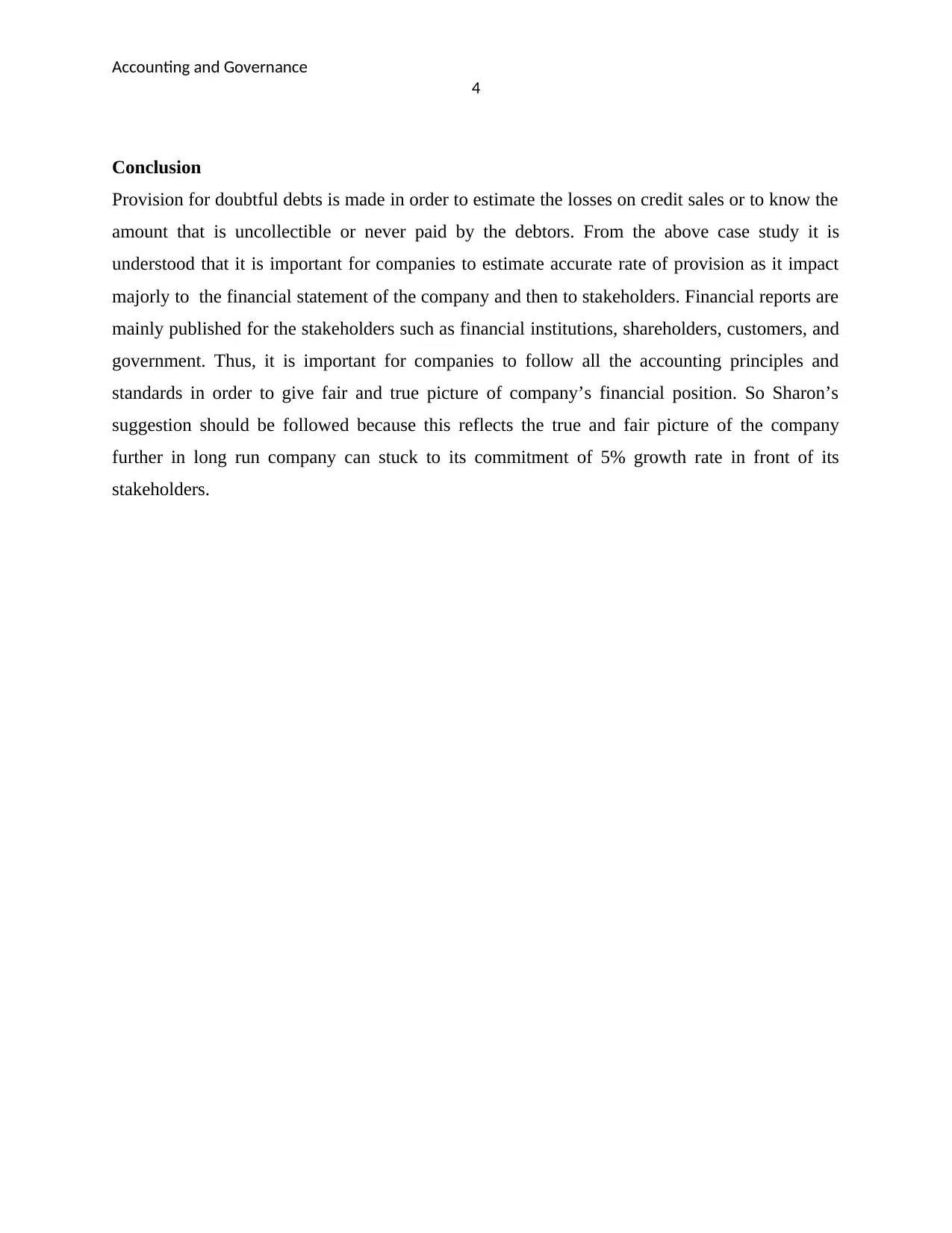
Accounting and Governance
4
Conclusion
Provision for doubtful debts is made in order to estimate the losses on credit sales or to know the
amount that is uncollectible or never paid by the debtors. From the above case study it is
understood that it is important for companies to estimate accurate rate of provision as it impact
majorly to the financial statement of the company and then to stakeholders. Financial reports are
mainly published for the stakeholders such as financial institutions, shareholders, customers, and
government. Thus, it is important for companies to follow all the accounting principles and
standards in order to give fair and true picture of company’s financial position. So Sharon’s
suggestion should be followed because this reflects the true and fair picture of the company
further in long run company can stuck to its commitment of 5% growth rate in front of its
stakeholders.
4
Conclusion
Provision for doubtful debts is made in order to estimate the losses on credit sales or to know the
amount that is uncollectible or never paid by the debtors. From the above case study it is
understood that it is important for companies to estimate accurate rate of provision as it impact
majorly to the financial statement of the company and then to stakeholders. Financial reports are
mainly published for the stakeholders such as financial institutions, shareholders, customers, and
government. Thus, it is important for companies to follow all the accounting principles and
standards in order to give fair and true picture of company’s financial position. So Sharon’s
suggestion should be followed because this reflects the true and fair picture of the company
further in long run company can stuck to its commitment of 5% growth rate in front of its
stakeholders.
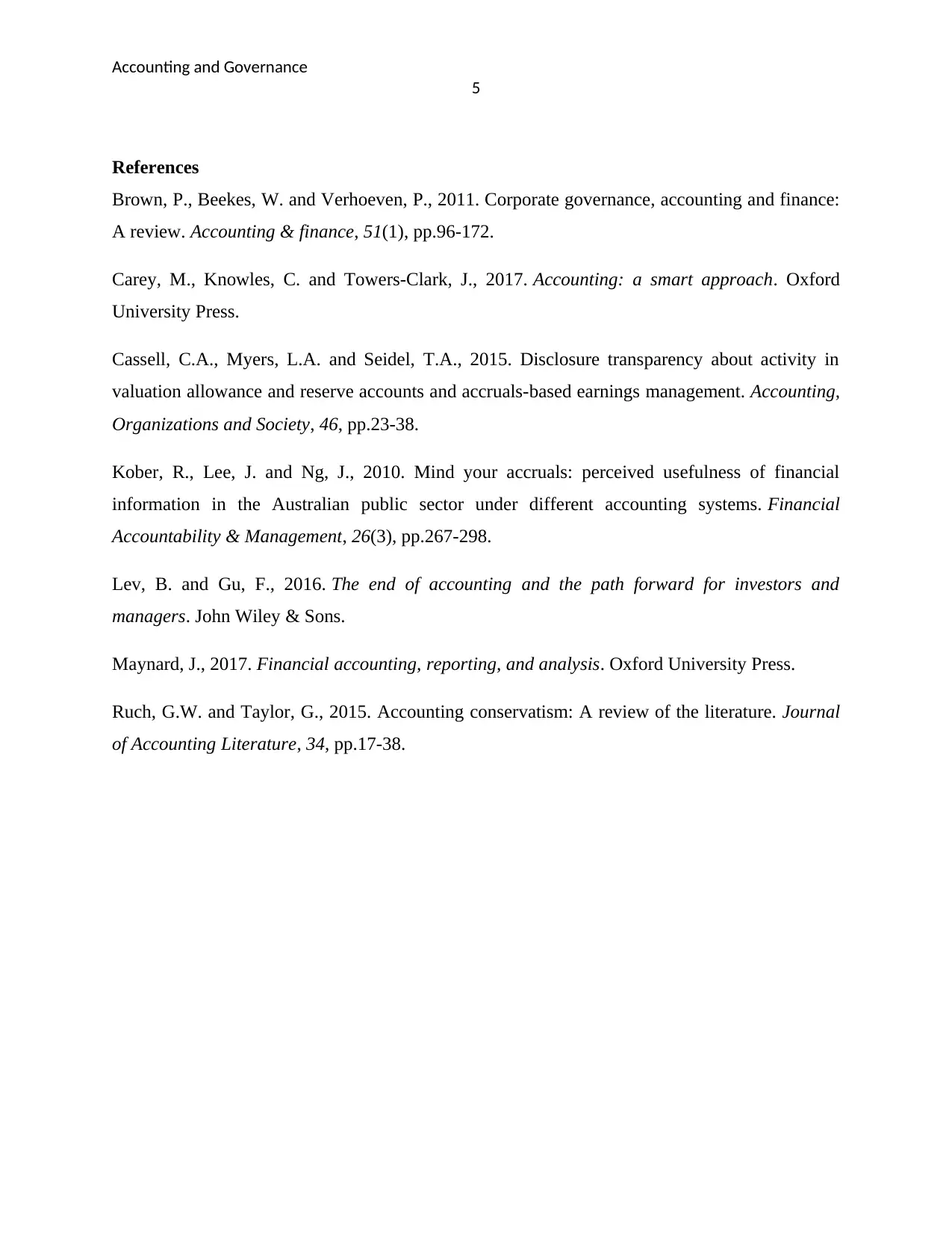
Accounting and Governance
5
References
Brown, P., Beekes, W. and Verhoeven, P., 2011. Corporate governance, accounting and finance:
A review. Accounting & finance, 51(1), pp.96-172.
Carey, M., Knowles, C. and Towers-Clark, J., 2017. Accounting: a smart approach. Oxford
University Press.
Cassell, C.A., Myers, L.A. and Seidel, T.A., 2015. Disclosure transparency about activity in
valuation allowance and reserve accounts and accruals-based earnings management. Accounting,
Organizations and Society, 46, pp.23-38.
Kober, R., Lee, J. and Ng, J., 2010. Mind your accruals: perceived usefulness of financial
information in the Australian public sector under different accounting systems. Financial
Accountability & Management, 26(3), pp.267-298.
Lev, B. and Gu, F., 2016. The end of accounting and the path forward for investors and
managers. John Wiley & Sons.
Maynard, J., 2017. Financial accounting, reporting, and analysis. Oxford University Press.
Ruch, G.W. and Taylor, G., 2015. Accounting conservatism: A review of the literature. Journal
of Accounting Literature, 34, pp.17-38.
5
References
Brown, P., Beekes, W. and Verhoeven, P., 2011. Corporate governance, accounting and finance:
A review. Accounting & finance, 51(1), pp.96-172.
Carey, M., Knowles, C. and Towers-Clark, J., 2017. Accounting: a smart approach. Oxford
University Press.
Cassell, C.A., Myers, L.A. and Seidel, T.A., 2015. Disclosure transparency about activity in
valuation allowance and reserve accounts and accruals-based earnings management. Accounting,
Organizations and Society, 46, pp.23-38.
Kober, R., Lee, J. and Ng, J., 2010. Mind your accruals: perceived usefulness of financial
information in the Australian public sector under different accounting systems. Financial
Accountability & Management, 26(3), pp.267-298.
Lev, B. and Gu, F., 2016. The end of accounting and the path forward for investors and
managers. John Wiley & Sons.
Maynard, J., 2017. Financial accounting, reporting, and analysis. Oxford University Press.
Ruch, G.W. and Taylor, G., 2015. Accounting conservatism: A review of the literature. Journal
of Accounting Literature, 34, pp.17-38.
⊘ This is a preview!⊘
Do you want full access?
Subscribe today to unlock all pages.

Trusted by 1+ million students worldwide
1 out of 6
Related Documents
Your All-in-One AI-Powered Toolkit for Academic Success.
+13062052269
info@desklib.com
Available 24*7 on WhatsApp / Email
![[object Object]](/_next/static/media/star-bottom.7253800d.svg)
Unlock your academic potential
Copyright © 2020–2025 A2Z Services. All Rights Reserved. Developed and managed by ZUCOL.





